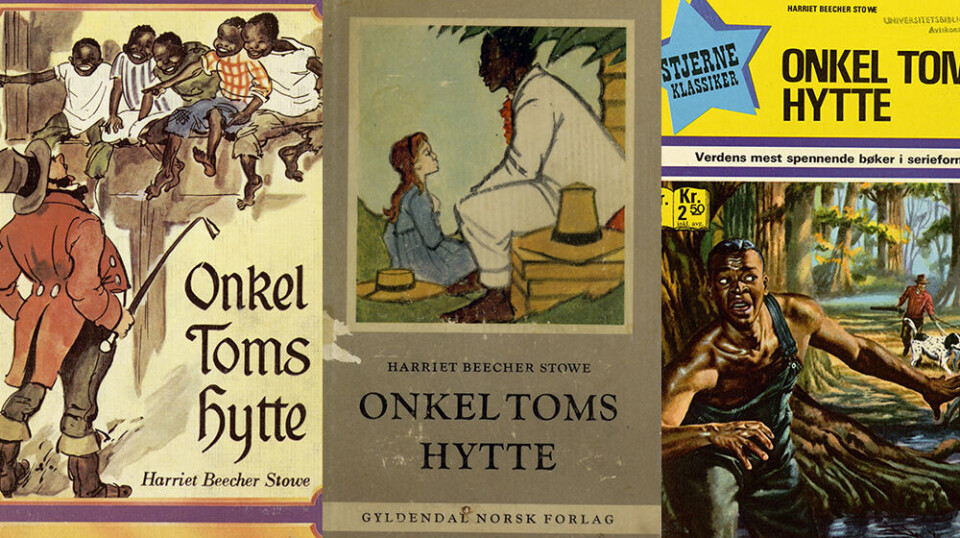THIS CONTENT IS BROUGHT TO YOU BY University of Oslo - read more

Researchers believe that Uncle Tom's Cabin in Norwegian reflects the evolution of the racism debate
The novel Uncle Tom's Cabin has been published in Norway 60 times. Researchers believe that the many editions and theatrical adaptations highlight how Norway has trailed behind in the racism debate.
When the novel Uncle Tom's Cabin was published in 1852, it became a tremendous success. The main character in the story is Tom, an enslaved man. The novel quickly gained significant political importance in its country of origin, the USA. It was published in Norway as a serialised novel the same year and as a novel the following year.
Researchers Aasta M. B. Bjørkøy and Janicke S. Kaasa have studied the Norwegian reception of the novel.
“This work has remained relevant since the mid-19th century. Several new editions have been released, and the reception in Norway has been entirely different from that in the United States,” says Kaasa.
She is an associate professor of Nordic literature at the University of Oslo.
Aside from the Bible, Uncle Tom's Cabin was the most printed book of the 20th century. In Norway, the book was published 60 times between 1852 and 2016; there were 34 different editions by 28 different publishers. The shortest edition was a 44-page comic book from 1957, the longest – the original version in book form from 1853 – was 644 pages.
A voice against slavery
In the United States, the novel quickly became an important voice against slavery, according to Bjørkøy, who is a professor of Nordic literature at the University of Oslo.
Author Harriet Beecher Stowe, though white, was deeply committed to the abolitionist cause. Her novel's portrayal of Tom – a character who, despite enduring severe mistreatment, remained steadfastly loyal to his owner – resonated powerfully with both children and adults.
In the Norwegian newspaper Den Norske Rigstidende on 12 March 1853, it read:
'Uncle Tom's Cabin [has] exerted an influence that no anti-slavery speech in Congress, no learned treatise on the subject, no political agitation, has ever managed to bring about (…) '
Later, the novel's reputation would change.
“Norway has trailed behind in the racism debate”
Bjørkøy and Kaasa have closely examined two Norwegian theatre productions from 1956 and 1966.
Although this was an important time for the civil rights movement in the USA – Martin Luther King was assassinated in 1968 – the theatres completely avoided politicising the productions.
As early as 1955, American author James Baldwin had criticised Uncle Tom's Cabin as ‘a very bad novel.’
“In the US, the novel has gradually taken on a more negative position, being seen as sentimental and racist. In Norway, it has been considered relatively harmless until very recently,” says Kaasa.
The researchers clearly observed this in the theatrical productions they studied, where the story primarily served an entertaining purpose. They also noted it in the press coverage of the productions.

They believe that this indicates how Norwegian society has long been behind in the racism debate.
“I don't believe we have understood racism here in the same way it has been perceived in the US. For instance, the use of the N-word was common in Norway until the 2000s, whereas people in the US recognised its problematic nature by the mid-20th century,” says Bjørkøy.
Unlike contemporary Norwegian literature
Uncle Tom’s Cabin became popular primarily because it entertained and moved readers, according to the researchers. As time passed and new editions were released, the political and religious messages in the text were toned down.
Stowe's original text has many passages where she directly addresses the reader to promote her political cause.
“These are largely removed in most Norwegian editions, which are more plot-driven. Uncle Tom's monologues are gone. This is often the case when texts are adapted for children and young people,” Kaasa explains.
The two researchers have not found much information about how Norwegian readers reacted to the story. An article in Norsk Skoletidende from 1898 is one exception: It talks about young people and adults in Rogaland who cried when the text was read aloud.
“It was a time dominated by edifying religious literature, and Stowe's novel became an exciting alternative. Her novel made people feel and think. Readers could understand what slavery entailed, even if they had not experienced it themselves,” says Bjørkøy.
May have increased the novel's status
Bjørkøy and Kaasa are not the first to research the reception and history of this novel in Norway.
Jon Haarberg, now professor emeritus at the University of Oslo, has called Uncle Tom’s Cabin a turning point for the dissemination of translated fiction in Norway.
“Haarberg believes that Uncle Tom's Cabin paved the way for the novel, both in Norway and internationally,” says Bjørkøy.
Before the mid-19th century, the novel was largely seen as socially harmful, associated with unsophisticated readers, and viewed as morally reprehensible.
In the second half of the 19th century, translated fiction was increasingly allowed into the press as serial literature. This is how Uncle Tom’s Cabin was first published, also in the United States.
According to Haarberg, Uncle Tom’s Cabin was significant primarily because it appealed to a broader audience than just female readers, the researchers explain.
A work is more than just the original text
The literary researchers believe that the history of Uncle Tom’s Cabin in Norway shows how a work can remain relevant over a longer period and find its place in a society different from the one in which it was written.
If you have read Uncle Tom's Cabin and meet someone else who has also read it, it is highly likely that you have read different versions, they explain.
Bjørkøy and Kaasa suggest that, in their view, a work is more than just the original text. It encompasses all the different versions that have emerged throughout history.
Should the book stay on the curriculum?
Even though the changes in the editions may seem to follow a straight line – with gradually less religious and political content – the publication history also has a chaotic nature, the researchers point out.
“In the latest edition from 2011, for example, the N-word was reintroduced after having been omitted in several previous editions. This translator wanted to keep the text close to the original,” Kaasa says.
If a new version were to be published today, Kaasa and Bjørkøy imagine that such a choice would likely be addressed in the afterword, something that did not happen in 2011.
In recent years, Kaasa has encountered literature students who have reacted negatively to the inclusion of Uncle Tom’s Cabin on the syllabus.
Both Kaasa and Bjørkøy believe that the book should still be read and discussed.
“We don't get an opportunity to become critical if we're not exposed to something to react to. Personally, I would be happy to read this book with older children and teenagers. But then I would use it as an opportunity to discuss the problematic aspects,” Bjørkøy says.
References:
Bjørkøy, A.M.B. & Kaasa, J.S. Den norske biografien til Onkel Toms Hytte (The Norwegian biography of Uncle Tom's Cabin), Nordica, 2022.
Bjørkøy, A.M.B. & Kaasa, J.S. 'The Norwegian-American Biography of Uncle Tom's Cabin: The Memorial Edition of 1897', Norwegian-American Studies, vol. 41, 2023. DOI: 10.1353/nor.2023.a909316 (Abstract)
Bjørkøy, A.M.B. & Kaasa, J.S. (forthcoming): «Fortell oss om Onkel Tom!» Onkel Toms hytte på den norske scenen, 1956 og 1966» ("Tell us about Uncle Tom!" Uncle Tom's Cabin on the Norwegian stage, 1956 and 1966) in Litterære rettighetskamper i Skandinavia, Universitetsforlaget.

This content is paid for and presented by the University of Oslo
This content is created by the University of Oslo's communication staff, who use this platform to communicate science and share results from research with the public. The University of Oslo is one of more than 80 owners of ScienceNorway.no. Read more here.
More content from the University of Oslo:
-
Queer opera singers: “I was too feminine, too ‘gay.’ I heard that on opera stages in both Asia and Europe”
-
Putin’s dream of the perfect family
-
How international standards are transforming the world
-
A researcher has listened to 480 versions of Hitler's favourite music. This is what he found
-
Researcher: "AI weakens our judgement"
-
New, worrying trend among incels, according to researcher




































